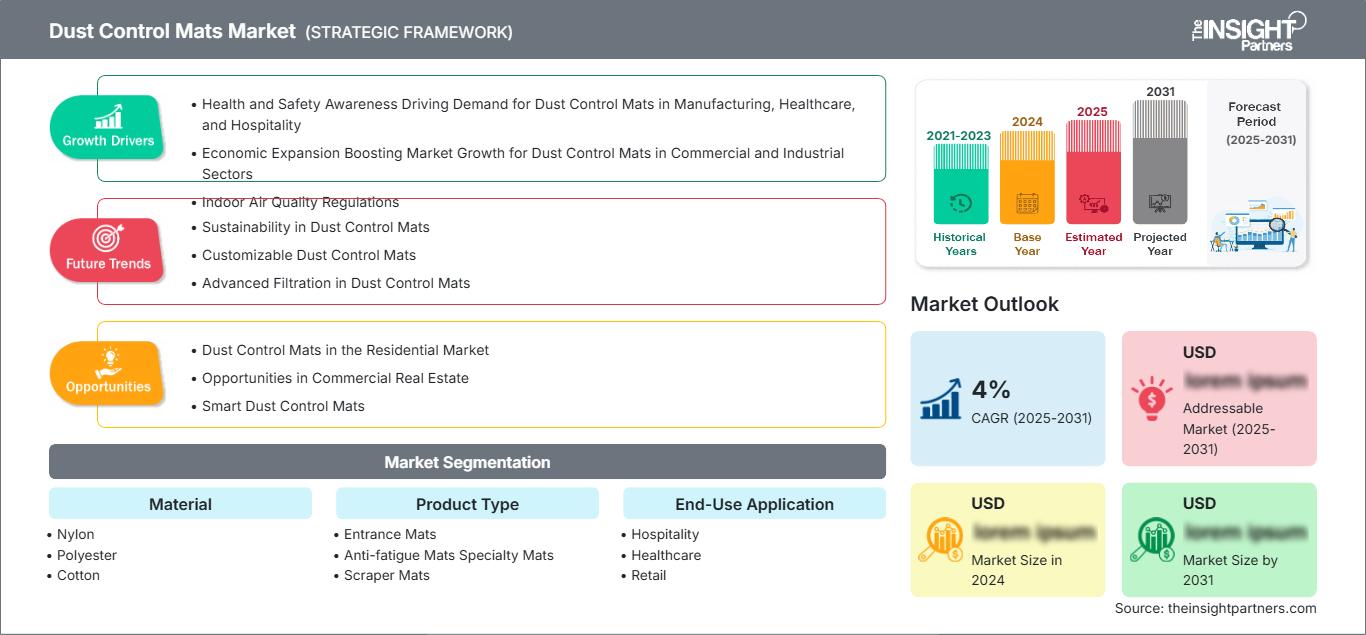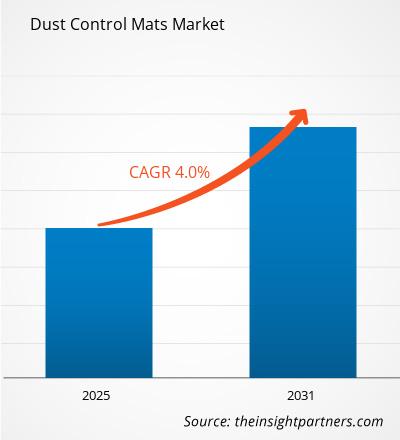Le marché des tapis anti-poussière devrait enregistrer un TCAC de 4 % entre 2025 et 2031, avec une taille de marché passant de XX millions de dollars américains en 2024 à XX millions de dollars américains d'ici 2031.
Le rapport est segmenté par matériau (nylon, polyester, coton, caoutchouc, microfibre, autres) et type de produit (tapis d'entrée, tapis anti-fatigue, tapis spéciaux, tapis grattoirs, tapis pour zones humides, autres). Le rapport présente également une analyse basée sur les applications finales (hôtellerie, santé, commerce de détail, fabrication, éducation, immeubles de bureaux, autres). L'analyse mondiale est ensuite ventilée par région et par principaux pays. Sur le plan géographique, le marché est divisé en Amérique du Nord, Europe, Asie-Pacifique, Moyen-Orient et Afrique, et Amérique du Sud et centrale. Le rapport présente la valeur en USD pour l'analyse et les segments ci-dessus.
Objectif du rapport
Le rapport sur le marché des tapis anti-poussière de The Insight Partners vise à décrire le paysage actuel et la croissance future, les principaux facteurs moteurs, les défis et les opportunités. Cela fournira des informations aux différentes parties prenantes de l'entreprise, telles que :
- Fournisseurs/fabricants de technologies : pour comprendre l'évolution de la dynamique du marché et connaître les opportunités de croissance potentielles, leur permettant de prendre des décisions stratégiques éclairées.
- Investisseurs : pour réaliser une analyse complète des tendances concernant le taux de croissance du marché, les projections financières du marché et les opportunités qui existent tout au long de la chaîne de valeur.
- Organismes de réglementation : pour réglementer les politiques et les activités de police sur le marché afin de minimiser les abus, de préserver la confiance des investisseurs et de maintenir l'intégrité et la stabilité du marché.
Segmentation du marché des tapis anti-poussière Matériau
- Nylon
- Polyester
- Coton
- Caoutchouc
- Microfibre
Type de produit
- Tapis d'entrée
- Tapis anti-fatigue Tapis spéciaux
- Tapis grattoirs
- Tapis pour zones humides
Application finale
- Hôtellerie
- Santé
- Commerce de détail
- Fabrication
- Éducation
- Immeubles de bureaux
Géographie
- Amérique du Nord
- Europe
- Asie-Pacifique
- Amérique du Sud et centrale
- Moyen-Orient et Afrique
Vous bénéficierez d’une personnalisation sur n’importe quel rapport - gratuitement - y compris des parties de ce rapport, ou une analyse au niveau du pays, un pack de données Excel, ainsi que de profiter d’offres exceptionnelles et de réductions pour les start-ups et les universités
Marché des tapis anti-poussière: Perspectives stratégiques

- Obtenez les principales tendances clés du marché de ce rapport.Cet échantillon GRATUIT comprendra une analyse de données, allant des tendances du marché aux estimations et prévisions.
Moteurs de croissance du marché des tapis anti-poussière
- La sensibilisation à la santé et à la sécurité stimule la demande de tapis anti-poussière dans les secteurs de la fabrication, de la santé et de l'hôtellerie : la sensibilisation aux normes de santé et de sécurité relatives aux personnes accélère la demande de tapis anti-poussière. Les tapis anti-poussière réduisent la diffusion de poussière et d'allergènes, contribuant ainsi à un environnement plus propre et donc plus sûr dans des secteurs comme la fabrication, la santé ou même l'hôtellerie.
- L'expansion économique stimule la croissance du marché des tapis anti-poussière dans les secteurs commercial et industriel : l'expansion économique dans les secteurs commercial et industriel, tels que les usines de fabrication, les entrepôts et les immeubles de bureaux, est un facteur d'influence essentiel pour le marché des tapis anti-poussière. Les tapis anti-poussière contrôlent efficacement la saleté, l'humidité et la poussière des pieds et ne salissent pas les lieux, résolvant ainsi le problème des zones à fort trafic et réduisant les coûts d'entretien.
- Réglementation sur la qualité de l'air intérieur : Les réglementations sur la qualité de l'air intérieur établies par divers gouvernements et organisations rendent les choses plus strictes, provoquant ainsi une forte demande de tapis anti-poussière. Les tapis anti-poussière maintiennent l'air intérieur sans saleté en piégeant les particules de poussière, répondant ainsi aux différentes normes d'hygiène environnementales et professionnelles pour les espaces commerciaux et industriels.
Tendances futures du marché des tapis anti-poussière
- Durabilité des tapis anti-poussière : La demande de tapis anti-poussière durables, fabriqués à partir de matériaux recyclables et renouvelables, est en augmentation. Face aux préoccupations environnementales croissantes, les consommateurs et les entreprises se tournent vers des produits tels que ces tapis, biodégradables, recyclables et/ou fabriqués à partir de ressources renouvelables, orientant ainsi l'ensemble du marché vers des produits plus écologiques.
- Tapis anti-poussière personnalisables : Tapis anti-poussière personnalisé : Indépendamment de la croissance économique, la personnalisation des tapis anti-poussière s'adapte à l'esthétique de l'entreprise. La plupart des entreprises proposent leurs tapis dans diverses couleurs, tailles et options de personnalisation, permettant aux entreprises d'avoir des produits fonctionnels dans leurs installations qui complètent l'apparence générale.
- Filtration avancée des tapis anti-poussière : Les tapis anti-poussière intègrent des technologies de filtration avancées, telles que des traitements antimicrobiens et anti-odeurs, pour assurer une meilleure capture de la poussière et maintenir un environnement plus propre. L'utilisation a été provoquée par la demande croissante d'hygiène et de qualité de l'air, en particulier dans les secteurs de la santé, de l'alimentation et de l'hôtellerie.
Opportunités de marché des tapis anti-poussière
- Tapis anti-poussière sur le marché résidentiel : Les tapis anti-poussière pourraient bientôt pénétrer le marché résidentiel en raison de la sensibilisation accrue des gens à la qualité de l'air intérieur et à la propreté. Les tapis sont connus pour piéger et réduire les particules de poussière et les allergènes dans les maisons pour un environnement de vie plus propre, en particulier pour les familles avec enfants ou animaux domestiques.
- Opportunités dans l'immobilier commercial : L'augmentation des opportunités sur le marché de l'immobilier commercial, des bureaux, des espaces commerciaux et des hôtels, offre des perspectives prometteuses aux fabricants de tapis anti-poussière. La propreté et l'esthétique devenant des pratiques importantes dans les lieux de travail, la demande de tapis esthétiques et fonctionnels, adaptés au maintien de la propreté des intérieurs, devrait également augmenter.
- Tapis anti-poussière intelligents : Un développement intelligent permettra aux tapis anti-poussière de devenir des produits de haute technologie adaptés à l'époque actuelle. Les fonctionnalités comprendront des capteurs qui mesurent le niveau de saleté ainsi qu'un nettoyage automatique. Ces innovations sauront séduire les technophiles et les entreprises exigeant le confort des fonctionnalités modernes.
Marché des tapis anti-poussière
Les tendances et facteurs régionaux influençant le marché des tapis anti-poussière tout au long de la période de prévision ont été analysés en détail par les analystes de The Insight Partners. Cette section aborde également les segments et la répartition géographique du marché des tapis anti-poussière en Amérique du Nord, en Europe, en Asie-Pacifique, au Moyen-Orient et en Afrique, ainsi qu'en Amérique du Sud et en Amérique centrale.Portée du rapport sur le marché des tapis anti-poussière| Attribut de rapport | Détails |
|---|---|
| Taille du marché en 2024 | US$ XX million |
| Taille du marché par 2031 | US$ XX Million |
| TCAC mondial (2025 - 2031) | 4% |
| Données historiques | 2021-2023 |
| Période de prévision | 2025-2031 |
| Segments couverts |
By Matériau
|
| Régions et pays couverts | Amérique du Nord
|
| Leaders du marché et profils d'entreprises clés |
|
Densité des acteurs du marché des tapis anti-poussière : comprendre son impact sur la dynamique commerciale
Le marché des tapis anti-poussière connaît une croissance rapide, porté par une demande croissante des utilisateurs finaux, due à des facteurs tels que l'évolution des préférences des consommateurs, les avancées technologiques et une meilleure connaissance des avantages du produit. Face à cette demande croissante, les entreprises élargissent leur offre, innovent pour répondre aux besoins des consommateurs et capitalisent sur les nouvelles tendances, ce qui alimente la croissance du marché.
- Obtenez le Marché des tapis anti-poussière Aperçu des principaux acteurs clés
Principaux arguments de vente
- Couverture exhaustive : Le rapport couvre l’analyse exhaustive des produits, services, types et utilisateurs finaux du marché des tapis anti-poussière, offrant un panorama global.
- Analyse d’experts : Le rapport est élaboré à partir d’une compréhension approfondie des experts et analystes du secteur.
- Informations actualisées : Le rapport garantit sa pertinence commerciale grâce à sa couverture des informations récentes et des tendances des données.
- Options de personnalisation : Ce rapport peut être personnalisé pour répondre aux besoins spécifiques des clients et s’adapter aux stratégies commerciales.
Le rapport de recherche sur le marché des tapis anti-poussière peut donc contribuer à la compréhension du marché et des perspectives de croissance. Malgré quelques préoccupations légitimes, les avantages globaux de ce rapport tendent à l’emporter sur les inconvénients.
- Analyse historique (2 ans), année de base, prévision (7 ans) avec TCAC
- Analyse PEST et SWOT
- Taille du marché Valeur / Volume - Mondial, Régional, Pays
- Industrie et paysage concurrentiel
- Ensemble de données Excel
Rapports récents
Témoignages
Raison d'acheter
- Prise de décision éclairée
- Compréhension de la dynamique du marché
- Analyse concurrentielle
- Connaissances clients
- Prévisions de marché
- Atténuation des risques
- Planification stratégique
- Justification des investissements
- Identification des marchés émergents
- Amélioration des stratégies marketing
- Amélioration de l'efficacité opérationnelle
- Alignement sur les tendances réglementaires




















 Obtenez un échantillon gratuit pour - Marché des tapis anti-poussière
Obtenez un échantillon gratuit pour - Marché des tapis anti-poussière